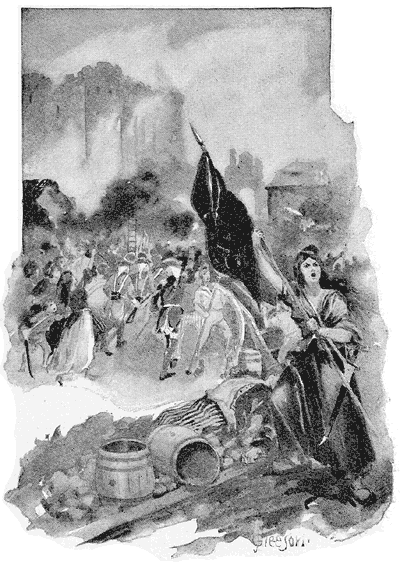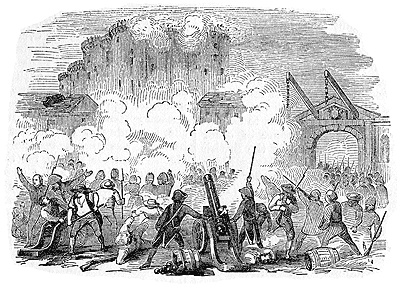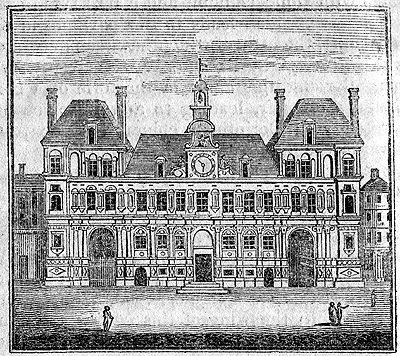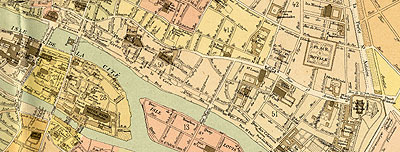|

NOTES ON ISSUE 9: GLOSSARY
PART 3 OF 3
…Defarge himself, already begrimed
with gunpowder and sweat, issued orders, issued arms, … laboured and
strove in the thickest of the uproar.
Monsieur Defarge, Dickens’ wine-merchant, is based on a historical
figure in the storming of the Bastille – a wine merchant named Cholat,
who is mentioned briefly by Carlyle in The French Revolution:
“Cholat the wine-merchant has become an impromptu cannoneer” (162).
Madame’s resolute right
hand was occupied with an axe, in place of the usual softer
instruments, and in her girdle were a pistol and a cruel knife.
Madame’s “usual softer instruments”
are presumably her knitting needles – probably “softer” because
associated with the more delicate operations of the domestic sphere.
(Madame Defarge’s knitting, however, is always ominous in A Tale of
Two Cities.) Her “girdle” refers to “a ceinture for the waist or
hips” (Fairholt 458) – a kind of belt. And the pistol she wears in her
girdle, together
with a knife, is a kind of “light fire-arm, first used in the early
part of the sixteenth century” (Fairholt 558).
“Come then!” cried Defarge, in a resounding voice.
“Patriots and friends, we are ready! The Bastille!”
The historic event described in this chapter is the famous fall of the
Bastille – the moment (July 14, 1789, commemorated annually as Bastille
Day) which marked the beginning of the French Revolution and the
symbolic fall of feudalism in Europe. Dickens’ account draws heavily
upon the account in his chief historical source, Carlyle’s French
Revolution. Carlyle’s version runs partly as follows:
All morning, since nine, there has
been a cry everywhere: To the Bastille! Repeated “deputations of
citizens” have been here, passionate for arms; whom De Launay [Marquis
de Launay, governor of the Bastille] has got dismissed by soft speeches
through port-holes. Towards noon, Elector Thuriot de la Rosière
gains admittance; finds De Launay indisposed for surrender; nay
disposed for blowing up the place rather. Thuriot mounts with him
to the battlements; heaps of paving-stones, old iron and missiles lie
piled; cannon all duly leveled; in every embrasure a cannon, – only
drawn back a little! But outwards, behold, O Thuriot, how the multitude
flows on, welling through every street; tocsin furiously pealing, all
drums beating the générale: the Suburb
Saint-Antoine rolling
hitherward wholly as one man!…
Woe to thee, De Launay, in such an hour, if thou canst not,
taking some one firm decision, rule circumstances!
Soft speeches will not serve; hard grapeshot is questionable;
but hovering between the two is unquestionable. Ever
wilder swells the tide of men; their infinite hum waxing ever
louder, into imprecations, perhaps into crackle of stray musketry,
– which latter, on walls nine feet thick, cannot do execution.
The Outer Drawbridge has been lowered for Thuriot; new deputation
of citizens (it is the third, and noisiest of all) penetrates
that way into the Outer Court: soft speeches producing no clearance
of these, De Launay gives fire; pulls up his Drawbridge. A slight
sputter; – which has kindled the too combustible
chaos; made it a roaring fire-chaos! Bursts forth Insurrection,
at sign of its own blood (for there were deaths by that sputter
of fire), into endless rolling explosion of musketry distraction,
execration; – and over head, from the Fortress, let one
great gun, with its grapeshot, go booming, to show what we could
do. The Bastille is besieged! (160-1)
Deep
ditches, double drawbridge, massive stone walls, eight great towers,
cannon, muskets, fire and smoke. Through the fire and through the smoke
– in the fire and in the smoke, for the sea cast him up against a
cannon, and on the instant he became a connonier – Defarge of the
wine-shop worked like a manful soldier, Two fierce hours.
Dickens’ description of the Bastille under siege – especially the
obscurity of fire and smoke – is itself a rendering of Carlyle’s
description in The French Revolution:
To
describe this Siege of the Bastille (thought to be one of the most
important in History) perhaps transcends the talent of mortals. Could
one but, after infinite reading, get to understand so much as the plan
of the building! But there is open Esplanade, at the end of the Rue
Saint-Antoine; there are such Forecourts, Cour Avancé,
Cour de l'Orme, arched Gateway…; then new drawbridges, dormant-bridges,
rampart-bastions, and the grim Eight Towers: a labyrinthic Mass,
high-frowning there, of all ages from twenty years to four hundred and
twenty; – beleaguered, in this its last hour, as we said, by mere Chaos
come again! Ordnance of all calibers; throats of all capacities; men of
all plans, every man his own engineer: seldom since the war of Pygmies
and Cranes was there so anomalous a thing. (161-2)
These illustrations, from –
respectively – the Artist’s Edition (1893) of Carlyle’s French
Revolution and the Book of Days (1864), show the
Bastille under siege.


A white flag from within
the fortress, and a parley – this dimly perceptible through the raging
storm, nothing audible in it – suddenly the sea rose … and swept
Defarge … over the lowered drawbridge, past the massive stone outer
walls, in among the eight great towers surrendered!
Again, elements in this passage draw on Carlyle’s descriptions in The
French Revolution. The first of the Bastille’s drawbridges having
been struck down, the second is besieged, and the defenders of the
Bastille “parley” – discuss terms – with the attackers. In The
French Revolution, the events between the appearance of the white
flag and the surrender of the eight great towers are described as
follows:
For four hours
now the World-Bedlam roared: call it the World-Chimera, blowing
fire! The poor Invalides [who defended the Bastille] have
sunk under their battlements, or rise only with reversed muskets:
they have made a white flag of napkins: go beating the chamade,
or seeming to beat, for one can hear nothing. The very Swiss
[Swiss mercenary guards, hired by the French government] at
the portcullis look weary of firing; disheartened in the fire-deluge:
a porthole at the drawbridge is opened, as by one that would
speak. See Huissier Maillard [a National Guardsman who took
a leading role in the attack on the Bastille and other Revolutionary
events, previously introduced by Carlyle as “a Stanislas
Maillard, riding-tipstaff (huissier à cheval)
of the Chatelet; one of the shiftiest of men?” (115)],
the shifty man! On his plank, swinging over the abyss of that
stone Ditch; plank resting on parapet, balanced by weight
of Patriots, – he hovers perilous: such a Dove towards
such an Ark! Deftly, thou shifty Usher: one man already fell;
and lies smashed, far down there, against the masonry! Usher
Maillard falls not: deftly, unerring he walks, with outspread
palm. The Swiss holds a paper through his porthole; the shifty
Usher snatches it, and returns. Terms of surrender: Pardon,
immunity to all! Are they accepted? – “Foi
d’officier, On the word of an officer,” answers
half-pay Hulin, – or half-pay Elie, for men do not agree
on it, “they are!” Sinks the drawbridge, –
Usher Maillard bolting it when down; rushes-in the living
deluge: the Bastille is fallen! Victoire! La Bastille
est prise! (165)
…as if he had been struggling
in the surf of the South Sea, until he was landed in the outer
court-yard of the Bastille.
The OED identifies the South Sea variously as the
Mediterranean, the English Channel, or the “Seas of the Southern
Hemisphere,” but especially the South Pacific Ocean. Dickens’ South Sea
is probably the latter, notorious for the ferocity of its surf, and
other kinds of ruinous instability – such as the famous 18th-century
boondoggle of the “South Sea Bubble.” (The South Sea Company,
incorporated in 1711, took on the English national debt “at a rate of
6% interest for a certain period of time, in return for having ‘the
duties upon certain articles … rendered permanent’ and a monopoly on
trade in the South Seas” [Book of Days 146]. So many people
invested that the market skyrocketed, and numerous “bubble companies”
arose. However, the market soon became unstable and collapsed, causing
– because of the extent to which private citizens had invested – a
national calamity.)
“Show me the North Tower!” said Defarge. “Quick!”
The North Tower – the site of Doctor Manette’s incarceration – is
Dickens’ fictional contribution to the architecture of the Bastille.
The Bastille had eight towers, two of which were on the north side –
the Tour du Puits and the Tour du Coin (Sanders 51); but neither of
these was called the North Tower. By generalizing the location (the
North Tower could be either of the northern towers of the Bastille),
Dickens opens up a space of fictional possibility within a historical
site.
Through gloomy vaults where the light of day had
never shown, past hideous doors of dark dens and cages, down cavernous
flights of steps, and again up steep rugged ascents of stone and brick,
more like dry waterfalls than staircases…
Monsieur Defarge and his companions, after the taking of the Bastille,
help to liberate it from the inside – a process which eventually led to
the total destruction of the prison (the physical fall that followed
the symbolic one). Carlyle describes this process partly as follows:
And
so it [the crowd] goes plunging through court and corridor; billowing
uncontrollable, firing from windows – on itself; in hot frenzy of
triumph, of grief and vengeance for its slain…. [A]shlar stones of the
Bastille continue thundering through the dusk; its paper archives shall
fly white. Old secrets come to view; the long-buried Despair finds
voice. Read this portion of an old Letter: “If for my consolation
Monseigneur would grant me, for the sake of God and the Most Blessed
Trinity, that I could have news of my dear wife; were it only her name
on a card, to show that she is alive! It were the greatest consolation
I could receive; and I should for ever bless the greatness of
Monseigneur.” Poor Prisoner, who named thyself Quéret-Démery,
and has no other history, – she is dead,
that dear wife of thine, and
thou art dead! ‘Tis fifty years since thy breaking heart put
this question; to be heard now first, and long heard, in the hearts of
men. (166-8)
He had still the linstock of
his gun in his own hand.
A linstock is a “staff about three feet long, having a pointed foot to
stick in the deck or ground, and a forked head to hold a lighted match”
(OED). Fairholt’s History of Dress (1860) describes
a linstock as follows:
LINSTOCK.
An ingenious invention of Italian origin, introduced in the fifteenth
century, and consisting of a pike, with branches on each side,
sometimes formed into the shape of a bird’s head, to hold a lighted
match for the cannoneer who used them, and who was thus capable of
defending himself with the same implement used for firing ordnance.
This image, from Fairholt’s History,
gives us an illustration of a linstock.

Otherwise, the governor [of the
Bastille] would not be marched to the Hôtel de Ville for
judgment.
The governor of the Bastille in 1789 was the Marquis de Launay, who –
failing to blow up the prison, as he threatened to, when the siege
began – was taken with the surrender of the Bastille. In Dickens’
version, Defarge is among those who physically seize de Launay and take
him
to the Hôtel de Ville – the Paris town hall.
The Hôtel de Ville standing in
Paris today is not the same
Hôtel de Ville that stood during the French Revolution, for the
latter was burned down by the revolutionaries of the Commune of
1871. However, even the Hôtel de Ville of Dickens’ time bore
little resemblance to the Hôtel de Ville to which de Launay was
escorted after the fall of the Bastille, for the edifice was damaged
during the French Revolution and restored and expanded at the beginning
of the 19th century. The original Hôtel de Ville was begun in
1533 to replace the Maison aux Piliers (a building named for the row of
pillars that supported it). However, as one 19th-century guidebook
notes,
The
building did not progress rapidly; in 1550 only one story was
completed. Then came the religious civil war, and the work was
suspended. In 1605 Henri IV was king, and François Miron provost
among the merchants [who had initiated work on the new building]. Work
was again commenced, and Miron from the emoluments of his office paid
for the façade of the building. The whole was completed in 1628.
This façade, very much smaller than that of the building
destroyed in 1871, stood in front of the open space … called La
Place de Grève. At each side there was a pavilion, or a
large wing, and in the center there was a campanile, or bell-tower.
Over the main gateway there was a fine equestrian statue in bas-relief
of Henri IV. This was the work of Pierre Biard, and was cut in black
marble. During the [French Revolution] the statue was destroyed; under
the Restoration [of the monarchy in the early 19th century] the king
was again put up, but in plaster; and the Government of July, in 1829,
moulded a statue in bronze…. (Dickens’s Dictionary of Paris
116)
This illustration of the Hôtel de Ville,
with the Place de Grève in the foreground, shows the
building approximately as it would have appeared in 1789. Though
the image, taken from Tronchet’s Picture of Paris
(c.1818), was engraved after the Revolution, it shows the Hôtel
in its restored state, and prior to its early-19th-century expansion.

The Place de Grève (“grève”
means “bank of the river”) is located on the north bank of the Seine.
It was later renamed La Place de l’Hôtel de Ville, and is famous
as a site of public executions in Paris up to and through the time of
the French Revolution. During the Terror, the guillotine was first
erected in the Place de Grève, but was afterwards moved to the
Place de la Révolution (now called the Place de la Concorde)
(Baedeker 174). After the Revolution, the Place de Grève again
became the usual
place of execution, but was later put to more pleasant uses: In
1801 and 1836, the Hôtel de Ville was enlarged, “increased by
three-fourths its former size” (Dickens’s Dictionary of Paris 116-7),
and this enlarged Hôtel de Ville was the site of fêtes
given by the city of Paris in the 19th century, the first of which
occurred before Dickens began to compose A Tale of Two Cities:
“The two great fêtes given at the Hôtel de Ville under the
Second Empire were upon the occasion of the visit of Queen Victoria and
Prince Albert to Paris in 1854, and in 1867, the year of the second
great Exhibition” (Dickens’s Dictionary of Paris 116-7). After
its destruction in 1871, the Hôtel de Ville was rebuilt to look
much as it had before the fire (Handbook to Paris 139), and
has survived in more or less the same state since. (According to Rough
Guide, it is an “oppressively gleaming and gargantuan mansion”
[117].) It is currently the seat of local government, with “one
whole
floor the private apartment of the mayor”; and an illustrated history
of the Hôtel de Ville – “always a prime target in riots and
revolutions” – is displayed “along the platform of M°
Châtelet on the Neuilly-Vincennes [Metro] line” (Baillie and
Salmon 117).
The relative positions of the Hôtel de Ville and the Bastille are
visible on this portion of the Plan de la Ville de Paris en 1789.
The Bastille is at the lower right; the Hôtel de Ville is marked
next to the Place de Grève, which lies on the north bank of the
Seine above the eastern end of the Ile de la Cité.

Click
on map for larger view
…this grim old officer [the governor of the
Bastille] in his grey coat and red decoration…
Dickens’ description of the Marquis de Launay echoes Carlyle’s,
especially in the detail of the prisoner’s dress:
De
Launay, “discovered in grey frock with poppy-coloured riband,” is for
killing himself with the sword of his cane. He shall to the Hôtel
de Ville; Hulin, Maillard and others escorting him; Elie marching
foremost “with the capitulation-paper on his sword’s point.” Through
roarings and cursings; through hustlings, clutchings, and at last
through strokes! Your escort is hustled aside, felled down; Hulin sinks
exhausted on a heap of stones. Miserable De Launay! He shall never
enter the Hôtel de Ville: only his “bloody hair-queue, held up in
a bloody hand”; that shall enter, for a sign. The bleeding trunk lies
on the steps there; the head is off through the streets; ghastly, aloft
on a pike. (166)
In Dickens’ version, it is Madame
Defarge who cuts off de Launay’s head.
Seven faces of prisoners, suddenly released by the
storm that had burst their tomb, were carried high over head: all
scared, all lost, all wondering and amazed, as if the Last Day had
come.
When the Bastille was taken on July 14, 1789, there were only seven
prisoners in it to be liberated (Carlyle notes that “Along the streets
of Paris circulate Seven Bastille Prisoners, borne shoulder-high”
[167], but does not emphasize that these seven were the only
seven). However, as a prison long devoted to the incarceration of
political prisoners, many of whom were confined there without trial as
a result of the infamous lettres de cachet, it had become
symbolic of the political caprices and injustices of the ancien
régime.
The “Last Day” is of course the
Day of Judgment (Revelations 20:12-13), when the dead are to
rise again (the implication being that the prisoners of the
Bastille were buried alive, and expected to be liberated only
with the final liberation of the Apocalypse). The seven prisoners
liberated from the Bastille consisted of “four forgers,
two lunatics, and a ‘jeune noble débauché’
– a disciple of the Marquis de Sade” (Sanders 119).
Bibliographical information
|

